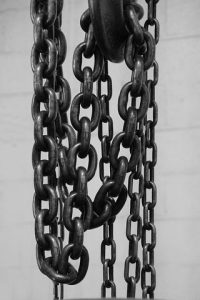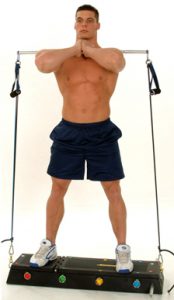If you’ve been hitting the gym trying to gain muscle, the sight of chains lying among the collections of weight collars, chalk blocks and other lifting accessories is a familiar sight. You may have seen them in action, too, clipped to a barbell for use during a bench press, deadlift or curl. To the average person, strapping a set of chains onto free weights during a workout might seem like a practice that’s too simple to be effective. Those who understand linear variable resistance, however, know that it is an effective, proven way to put on muscle mass and increase strength.
What is Linear Variable Resistance?
Linear variable resistance (LVR) occurs when the load increases as you lift, maxing out at its heaviest at the top of the exercise. As Jim Stoppani, Ph.D., and Rob Fitzgerald, N.S.C.A.-C.P.T1, explained, without chains, you never really get a chance to lift as much as you’re capable of because the beginning of any exercise is where you’re weakest. With chains, however, the bulk of the weight is piled on the floor so, as you lift the weight, the chain lifts with it, link by link, constantly increasing the amount of weight you’re moving until you get to the top of the exercise.
How You Gain Muscle With Linear Variable Resistance
 Among the muscle gain secrets, LVR is one of the simplest to implement. It works so well because it gives you a break when you’re weakest during an exercise and loads you up to recruit additional fast-twitch muscles as you reach the top of the move. Those particular muscles are the important ones for gaining muscle mass and strength because they contract the strongest and fastest. They’re also the ones that, trained consistently and correctly, will grow the biggest.
Among the muscle gain secrets, LVR is one of the simplest to implement. It works so well because it gives you a break when you’re weakest during an exercise and loads you up to recruit additional fast-twitch muscles as you reach the top of the move. Those particular muscles are the important ones for gaining muscle mass and strength because they contract the strongest and fastest. They’re also the ones that, trained consistently and correctly, will grow the biggest.
Shake Off the Chains
Now that you know how to gain muscle mass with linear variable resistance, it’s understandable if you want to start hooking up the chains to activate some LVR. However, what if you could challenge your muscles even further to enhance your mass and strength gains faster using the same exercises? You can do exactly that if you use resistance bands to produce LVR. In an article for Muscle and Fitness, Jim Stoppani reveals that bands not only increase in resistance as you move to the top of an exercise, but they increase in speed as you move through the negative segment of an exercise. In order to stop the weight at the bottom of the move, you have to apply more force, engaging even more muscle fibers to maintain control of the weight.
Most gyms are equipped with bands, but if you’re serious about setting LVR in motion, you need resistance training equipment that’s designed around the concept. It’s useful to strength and muscle gains to chain up for exercises that will accommodate chains, but performing all of the exercises in your workout using bands will benefit those fast-twitch muscle fibers even more. With the capability to perform real gym exercises, the TargitFit Trainer is an essential tool for anyone who wants to gain muscle and strength — and with the latest accessories, the TargitFit can do all the exercises you do with free weights in the gym, including pull-downs, squats and standing crossovers. TargitFit will give you the “chain reaction” without the chains.
1Stoppani, Jim; Fitzgerald, Rob. “Chain of Command.” Muscle and Fitness. January 2010. Print.



Pingback: Muscle Mass on Women: The Health and Fitness Homerun | Targitfit Blog
Very good site. Thanks for such a great information.